

4/8/03 - Two eggs. One foster egg added.
5/21/03 - Chick #3 (the oldest, a male) dead. No signs of abuse, full crop, heathly appearance. No ants on corpse, no rigor mortis so it must have died within a few hours of being discovered. Bagged corpse and placed in fridge for potential necropsy. This day it was 90 degrees F in my room, with the door open, the window open, and two fans going. Heat was likely the cause of death, as there were five chicks in a lovebird-size nestbox, and the one that died was also the largest. Two chicks were initially pulled for handfeeding, but I chickened out and pulled a third.
This hen had to be the one laying eggs on the wire, since the hen in L5 was laying as scheduled in her box.
5/12/03 - Kak eggs inspected and found to be cracked or punctured. Eggs opened to determine status: one early DIS, one late DIS (had an aircell that took up over half the egg) and two infertile. Hybrid conure egg laid on floor of their nonbreeding cage; placed in L6.
5/21/03 - One conure egg, one tiel egg. Both inspected and found cracked or punctured. Removed.
5/24/03 - Box chick continues to thrive. Heat is still my prime suspect for the death of #3. The other chicks finally adjusted to handfeeding, and cry to be fed whenever they see a human. Handfeds being fed every three hours from 7:00 a.m. to 11:00 p.m.
5/25/03 - Box chick gaining more weight than handfeds, possibly due to lag caused by adjustment time. Smallest handfed returned to nestbox at 11:45 a.m. Checked on chick at 1:00 p.m. and found it well, with full crop.
5/26/03 - Returned two other handfeds to nest. Checked on all four in evening and found them fed and well.
5/28/03 - Another hot day. I cleaned the aviaries and then gave everyone a good soaking. The tiels really appreciated it. I'd like to get a mister system set up, but my current aviaries aren't well designed for that kind of drainage. The last thing I need is wet food and feces rotting on the floor in hot weather. Since it will probably stay this hot, I plan on keeping the three oldest chicks out of the nest. It's so hot in my room that the brooder doesn't even need to be turned on. Here are some pics of them, all taken today:
5/31/03 - By this time, kak chicks are very mobile and capable of getting into trouble. It's hard to even get a picture of them outside of the brooder because they won't sit still for two seconds. The chicks are also trying to preen each other now.
My coworkers know next to nothing about birds, but it's fun to help spread the knowledge. Today when I walked into work, my supervisor remarked on the "new" birds I was bringing. I explained that these were the same ones I brought on Saturday. "But they're green!" I explained that the grey was only the down feathers, and that these were the real ones growing in. Those of you familiar with kakarikis will notice a few differences between chicks and adults. Chicks have less red, and their beaks are horn-colored, not silver and black. A huge difference is the eyes, which are brown. Adult kaks have striking red-orange eyes, something obviously missing from the chicks.
They should start flying sometime this week. I'm dreading that day...
6/4/03 - At home, the chicks are kept inside a 10 gallon aquarium, so they have plenty of room. At work, they are in a travel brooder about half that size. Today they were making a complete mess of it as they tore up the paper and searched for food (and poop) to pick at. I did see one picking at a cherry. How exciting! They also began reducing the amount of formula they'll take in one sitting.
The short flights began today. I've ceased using my ceiling fan and had to plug up a hole in my bedroom door. The cat will also be banned from my room more than usual.
6/6/03 - Tragedy strikes. I was letting my active babies run around on the playstand top of Loki's cage. I put up a screen and several towels around the back to keep them from falling behind the very large, cumbersome cage. Despite my barrier, one chick managed to get down behind and became stuck. As I pulled the cage away from the wall, my barrier collapsed and a second chick tumbled behind. Unfortunately, a large bump in the chair mat below prevented me from simply rolling the cage out. I had to lift it up one corner of the cage to get over the bump. As I did so, one chick (#4) ran under the wheel. I didn't see it, but I heard the baby squeal when I set the cage corner down again. I quickly lifted the cage again to release the chick, then finished pulling it away so I could to them. It was too late. My poor baby died less than 30 seconds later. The remaining chicks, Loki and I were all pretty shaken by what happened.
This event demonstrates an important point about keeping birds: no matter how much you try to "bird-proof" your home, human error will always remain a possibility. In memory.
6/7/03 - The chicks are now munching on their food, rather than just picking at it. I started offering Crazy Corn and veggies a few days ago. They also started making short flights from the bed to the floor, but are still too heavy to gain any lift, particularly after handfeeding. It can be hard to sex young kakarikis unless you have one of each gender to look at, but I am fairly certain that both birds are hens. They are both dainty.
Because of yesterday, neither are allowed on Loki's cage until they can fly well. Instead, they are allowed on the bed. The oldest likes to sit on my shoulder while I feed her sister and clean up the handfeeding area. Neither like being pet. The younger one sometimes squeals when I pick it up, and I think this is due to what happened yesterday. I'll have to work on regaining its trust.
The one chick in the nestbox continues to do well. It is the youngest, so feather growth is behind that of the handfeds. I added more nestboxes earlier this week, and its mother is currently scoping out a new box. The weather has been alternating lately though- cool and overcast in the mornings (June gloom), and warm and sunny in the afternoons. The kaks don't like heat, so there's a good chance she won't actually nest again.
6/8/03 - As I was staring forlornly at Loki's playstand, I suddenly got an idea. Why not enclose the area in wire? The kaks are old enough for a cage now, and my new place doesn't offer much in the way of room. The 10 gallon brooder fits just fine, but squeezing a cage into the same spot would be problematic. Then there's also the fact that I've got more chicks on the way- the budgie and tiel eggs began hatching yesterday. With chicks ranging in age I would need room for both brooder and cage, and the cage would have to be large enough to hold quite a few tiel chicks later in the season. The only cage that fits in the same space as the brooder is quite small. I had planned on sacrificing my desk or dresser top to hold a larger cage, but this would make cleaning a pain, and the space is already in use. I took measurements of Loki's cage and headed for the hardware store.
I did all the work in my room. Not the best place, but I wanted to listen to tunes. Loki was very good about playing by himself in his cage while I worked, and never really bothered me to be let out. I ended up using five separate pieces: one for the sides and back, one for the front (I miscalculated and cut too soon, this was intended to be connected to the last piece), one for the door and two for the top. I had plain wire string and fasteners left over from the second aviary I bought. I used the fasteners to secure all the pieces together, except for where the two pieces on the top joined; here I used the wire string to weave them together. I absolutely hate applying the metal fasteners. I've got pliers that can crimp the clips on, but they are too fat to fit between the wire for application. I first have to bend the clips slightly so that the ends won't meet, then crimp them halfway, then hold them in place with needle nose pliers while I (hopefully) grab and crimp them with the fatter pliers. It's a real pain.
During construction, I noticed a problem with my initial design. While the wire would indeed enclose the top of the cage, it still would leave a large gap between the tray and the wire. While a tiel or male kak would not be able to squeeze through, a female kak or budgie could. In either case, a chick could become trapped or injured while trying to get through. I needed to be able to block the gap, while not blocking the use of the tray. I opted for towels as a temporary solution today, and will either extent another layer of wire on the inside or put up something else (plastic?). Someone suggested using cardboard, but this is too easily soiled and destructible.
After cutting and assembly, I took the cage out to be washed. All galvanized wire should be scrubbed with a water/vinegar solution before you allow birds to come into contact with it. This process removes any excess zinc. My wire was particularly dirty, and seemed to have small particles of metal clinging to it.
Aside from the gap and problems with the door (I couldn't find a suitable latch for it at the hardware store), the cage turned out quite nice. Now my weaning chicks have a nice, safe place to play. The cage also has more of an "open" feel to it. Here is another pic of the finished cage.
The chicks also started flying today- not well, but they have lift.
6/12/03 - The chicks are now on 3-4 feedings a day. They are fed in the morning (not much food taken), in the afternoon and in the evening. I no longer bring them to work with me, as they are too big and active to stay in a brooder all day long. I loaded up the weaning cage with several foods, but none were actually eaten. You can check if weaning birds are actually consuming food by blowing apart the feathers over the crop area and looking. The chicks are really enjoying their new weaning cage and are also flying quite well now.
6/13/03 - Good news! My hen has indeed begun to nest again, and laid two eggs! I recently applied open plastic bands to a couple of my kak hens because it is hard to tell them apart. The one currently nesting has the yellow band.
The chick I left in the aviary (the youngest) fledged today. Like the two I am handfeeding, this one is also a female. It looks like I lost the only male to the heat back on 5/21/03. In the first picture, you can again see the difference between an adult bird (left) and the juvenile (right). The juvenile has a horn-colored beak tipped with black, as opposed to the silver of an adult. The red is also much lighter and less extensive. The eyes are brown, not bright orange (the adult's eyes appear dark due to the flash).
The other chicks are down to three feedings, but only eat well in the evening, despite a lot of begging. They are very active.
6/15/03 - The hen now has three eggs.
I skipped the morning feeding today and didn't offer any formula until nearly 6:00 p.m. At that time, one chick refused to be fed completely and the other only took a couple mouthfuls. I returned them to the weaning cage and cooked another round of Crazy Corn and veggies, which they immediately went for. They've been picking at seed for the past two days and I found husk in their bowl today, though only from one type of seed. At this rate they will probably wean in a day or two. As you can see, kaks wean very abruptly.
6/20/03 - Five eggs. Both chicks now refuse formula, and demand soft foods in the morning and afternoon. Chick #6 is still mad at me. I had to bring a net into my room so that I can catch her faster.
6/22/03 - Six eggs. The chicks demand to be let out of the weaning cage, and vigorously fly in circles around my ceiling for about 15 minutes before deciding to explore.
6/26/03 - I moved the two handfeds out into the aviary. The weaning cage just didn't give them enough flight area, and getting them back in the cage after letting them out was becoming a real pain.
Nestbox L5
4/10/03 - Four eggs.
4/20/03 - Six eggs.
4/25/03 - Six eggs, at least four fertile.
5/1/03 - Three chicks, three eggs.
5/4/03 - Five chicks, one egg.
5/6/03 - Five chicks, one egg.
5/12/03 - Five chicks. Banded numbers 3-6.
5/15/03 - Five chicks. Banded number 7.Nestbox L6
4/8/03 - One egg laid on wire (placed in L5).
4/10/03 - Another egg laid on wire (this one was broken).
4/20/03 - Broken eggshell found in box.
4/25/03 - Three eggs.
5/1/03 - Four eggs.
5/4/03 - Four eggs.
5/6/03 - Four eggs. Cockatiel egg laid on floor of flight #2 (nonbreeding flight); placed in L6.
5/22/03 - Remaining chick in nestbox doing fine. The other chicks adjusting to handfeeding, but alert and fine.
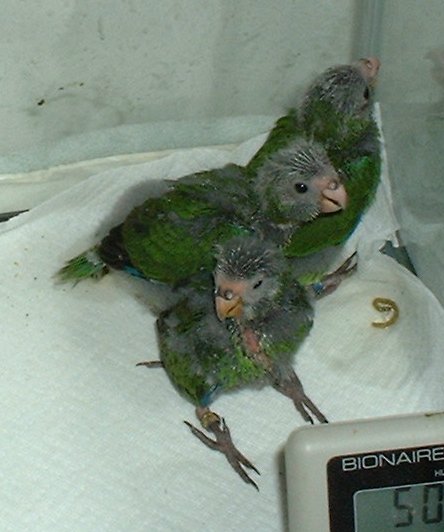 5/27/03 - In the morning I checked online for a daily forcast, and found that it would be 85 degrees. Thinking the chicks would be fine at this temperature, I left them in the nestbox. Once at work, I learned that it was going to hit 100 degrees, and I had to take an extended break to drive home and fetch them. I pulled the oldest three and left the youngest in the box. It didn't get quite that hot, but it was certainly hotter than I had anticipated. I also took another kak hen to the vet that day, because her abdomen was swollen but she wasn't laying. My vet said that she was just broody and the swelling was due to her enlarged ovary. She said my hen had probably wanted to lay, but that the sudden change to hot weather was making her think twice.
5/27/03 - In the morning I checked online for a daily forcast, and found that it would be 85 degrees. Thinking the chicks would be fine at this temperature, I left them in the nestbox. Once at work, I learned that it was going to hit 100 degrees, and I had to take an extended break to drive home and fetch them. I pulled the oldest three and left the youngest in the box. It didn't get quite that hot, but it was certainly hotter than I had anticipated. I also took another kak hen to the vet that day, because her abdomen was swollen but she wasn't laying. My vet said that she was just broody and the swelling was due to her enlarged ovary. She said my hen had probably wanted to lay, but that the sudden change to hot weather was making her think twice.
Full of food, now what? | Time to Start Exercising Those Wings | Flapping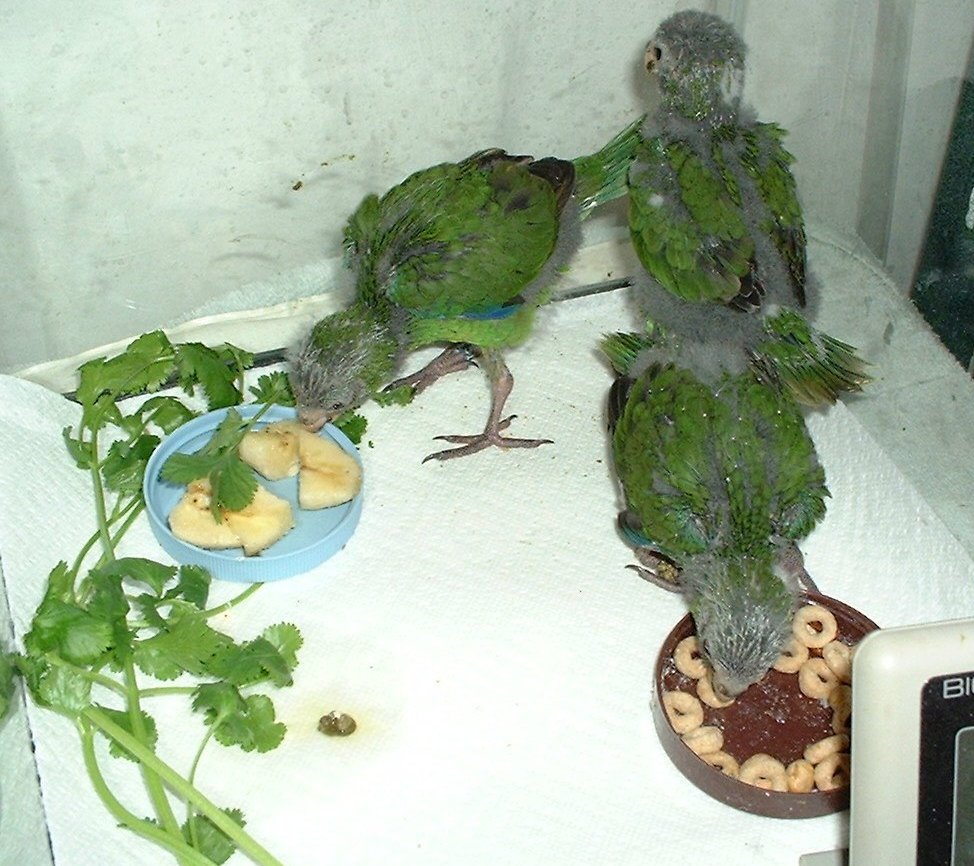 5/29/03 - I started offering weaning foods yesterday, since the chicks were spending so much time picking at their poop, their toes and each other. Many handfeeders love to use Cheerios as a weaning food, because it is easy for the chicks (even small species) to pick up and manipulate. Parsley and banana are two other beginning weaning foods I like. Banana was the first weaning food that Toast ate, followed by parsley. I offer most weaning foods in a shallow dish, not that they stay there for long! I've tried many times to place the weaning foods at the opposite side of the brooder, but this just leads to chicks picking at their poop again. If you want them to play with the weaning foods, they have to be placed right near the chicks, even though they'll get trampled and kicked about.
5/29/03 - I started offering weaning foods yesterday, since the chicks were spending so much time picking at their poop, their toes and each other. Many handfeeders love to use Cheerios as a weaning food, because it is easy for the chicks (even small species) to pick up and manipulate. Parsley and banana are two other beginning weaning foods I like. Banana was the first weaning food that Toast ate, followed by parsley. I offer most weaning foods in a shallow dish, not that they stay there for long! I've tried many times to place the weaning foods at the opposite side of the brooder, but this just leads to chicks picking at their poop again. If you want them to play with the weaning foods, they have to be placed right near the chicks, even though they'll get trampled and kicked about.
6/3/03 - It is interesting to note people's reactions to the kakariki chicks. I usually feed cockatiels, so most of the people who see me handfed have never seen the kaks. The species are as different as night and day. Cockatiels hiss loudly when disturbed, while the kaks just make a gentle "wa wa wa," if they make noise at all. Despite being startled by their noise more than once, my coworkers unanimously prefer the cockatiel chicks as being "cuter." During feeding, cockatiels beg very loudly and have a strong pumping motion for a feeding response. Kaks peep slightly louder when they want to be fed, and have a minimal feeding response. From a handfeeder standpoint, loud and vigorous is much better. I can feed the tiels in record time, and they always fill their crops. The kaks are more of a pain. They take one dose of formula, then temporarily lose interest. This means that I have to keep cycling through the chicks until everyone is actually "full." Mind you, they don't actually get "full." Kaks don't like their crops filled more than ½ to 3/4 of the way. This means that they need to be fed more often. Their metabolism is also faster than that of tiels. Older tiels may be able to go 4-6 hours before needing to be fed. Even at this age, kaks need to be fed every 2-3 hours. Needless to say, I much prefer handfeeding cockatiels. However, my stepmother, who doesn't like the loud cries of feeding tiels, told me I should stick to handfeeding kakarikis.

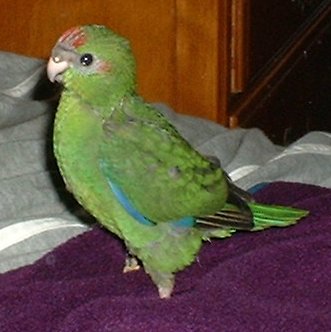
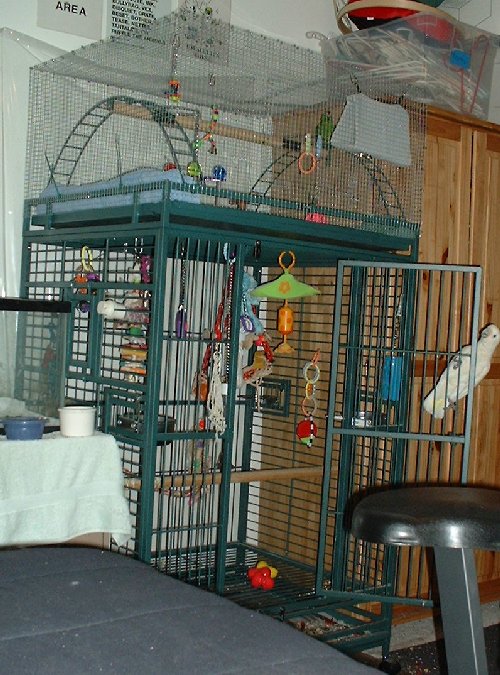 They had roll wire, but not the kind I wanted. I was looking for wire spacing of 1-2 inches by ½ an inch, which is usually a stronger gauge, but they only had ½ by ½. The playtop is 30" W x 35.5" L x 17" H. The wire came in a maximum of 24" wide, meaning that I would have to use several separate pieces to construct the cage. It would have to do.
They had roll wire, but not the kind I wanted. I was looking for wire spacing of 1-2 inches by ½ an inch, which is usually a stronger gauge, but they only had ½ by ½. The playtop is 30" W x 35.5" L x 17" H. The wire came in a maximum of 24" wide, meaning that I would have to use several separate pieces to construct the cage. It would have to do.
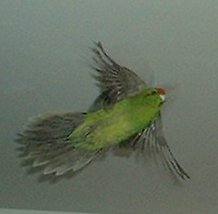
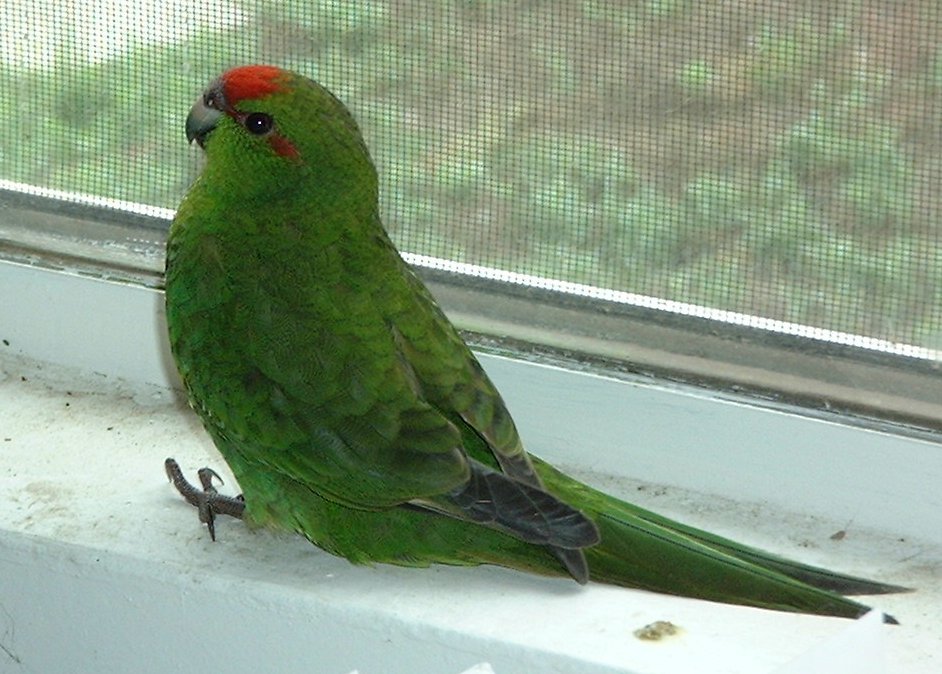 6/18/03 - Four eggs. Chick #6 has not taken any formula since 6/15/03. Chick #5 sometimes asks for formula in the evening, but takes only a mouthful. Chick #6 has learning she can avoid going back in the cage if she flies away from my hands. I eventually caught her and now she's mad at me.
6/18/03 - Four eggs. Chick #6 has not taken any formula since 6/15/03. Chick #5 sometimes asks for formula in the evening, but takes only a mouthful. Chick #6 has learning she can avoid going back in the cage if she flies away from my hands. I eventually caught her and now she's mad at me.
6/30/03 - I mistook the parent-raised bird for one of my handfeds, and offered it a finger. She was initially put off, but became curious after I sat down and one of last year's handfeds perched on me. I was able to get her to step up, and she constantly tried to nibble on my skin (a bad habit of kaks).

Articles and images contained on this site are © 2003 by Karen Trinkaus unless otherwise noted and may not be reprinted or used in any way without the author's permission.